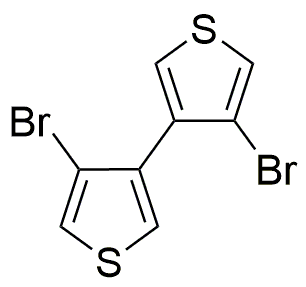4,4'-Dibromo-3,3'-bithiophene is widely utilized in research focused on:
- Organic Electronics: This compound is a key material in the development of organic semiconductors, particularly in organic photovoltaic cells and organic light-emitting diodes (OLEDs). Its unique electronic properties enhance device efficiency.
- Conductive Polymers: It serves as a building block for synthesizing conductive polymers, which are essential in various applications such as flexible electronics and sensors, offering advantages over traditional materials due to their lightweight and flexibility.
- Material Science: The compound is used in the creation of advanced materials with tailored properties, such as improved thermal stability and conductivity, making it valuable in the development of high-performance coatings and composites.
- Research in Photonics: Its properties are leveraged in photonic applications, including waveguides and lasers, where its ability to manipulate light can lead to innovations in communication technologies.
- Environmental Sensors: The compound is explored for use in sensors that detect environmental pollutants, providing a means for real-time monitoring and contributing to sustainability efforts.
Informations générales
Propriétés
Sécurité et réglementation
Applications
4,4'-Dibromo-3,3'-bithiophene is widely utilized in research focused on:
- Organic Electronics: This compound is a key material in the development of organic semiconductors, particularly in organic photovoltaic cells and organic light-emitting diodes (OLEDs). Its unique electronic properties enhance device efficiency.
- Conductive Polymers: It serves as a building block for synthesizing conductive polymers, which are essential in various applications such as flexible electronics and sensors, offering advantages over traditional materials due to their lightweight and flexibility.
- Material Science: The compound is used in the creation of advanced materials with tailored properties, such as improved thermal stability and conductivity, making it valuable in the development of high-performance coatings and composites.
- Research in Photonics: Its properties are leveraged in photonic applications, including waveguides and lasers, where its ability to manipulate light can lead to innovations in communication technologies.
- Environmental Sensors: The compound is explored for use in sensors that detect environmental pollutants, providing a means for real-time monitoring and contributing to sustainability efforts.
Documents
Fiches de données de sécurité (FDS)
La FDS fournit des informations de sécurité complètes sur la manipulation, le stockage et l’élimination du produit.
Spécifications du produit (PS)
Le PS fournit une description complète des propriétés du produit, notamment sa composition chimique, son état physique, sa pureté et les exigences de stockage. Il détaille également les plages de qualité acceptables et les applications prévues du produit.
Certificats d'analyse (COA)
Recherchez des certificats d'analyse (COA) en saisissant le numéro de lot du produit. Les numéros de lot et de lot se trouvent sur l'étiquette d'un produit, après les mots « Lot » ou « Lot de fabrication ».
Numéro de catalogue
Numéro de lot/série
Certificats d'origine (COO)
Ce certificat d'exploitation confirme le pays dans lequel le produit a été fabriqué, et détaille également les matériaux et composants utilisés et s'il est issu de sources naturelles, synthétiques ou autres sources spécifiques. Ce certificat peut être requis pour les douanes, le commerce et la conformité réglementaire.
Numéro de catalogue
Numéro de lot/série
Fiches de données de sécurité (FDS)
La FDS fournit des informations de sécurité complètes sur la manipulation, le stockage et l’élimination du produit.
DownloadSpécifications du produit (PS)
Le PS fournit une description complète des propriétés du produit, notamment sa composition chimique, son état physique, sa pureté et les exigences de stockage. Il détaille également les plages de qualité acceptables et les applications prévues du produit.
DownloadCertificats d'analyse (COA)
Recherchez des certificats d'analyse (COA) en saisissant le numéro de lot du produit. Les numéros de lot et de lot se trouvent sur l'étiquette d'un produit, après les mots « Lot » ou « Lot de fabrication ».
Numéro de catalogue
Numéro de lot/série
Certificats d'origine (COO)
Ce certificat d'exploitation confirme le pays dans lequel le produit a été fabriqué, et détaille également les matériaux et composants utilisés et s'il est issu de sources naturelles, synthétiques ou autres sources spécifiques. Ce certificat peut être requis pour les douanes, le commerce et la conformité réglementaire.


